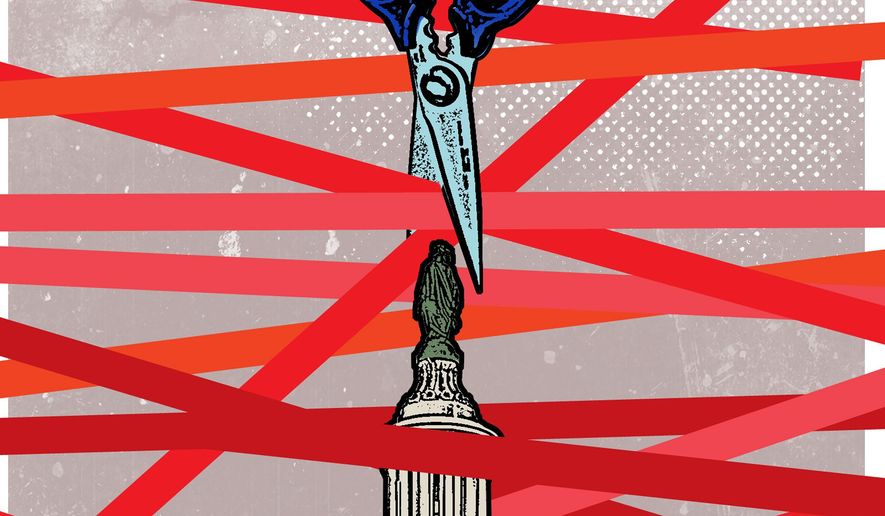OPINION:
Conservatives and Republicans feel winds in their sails about reclaiming the White House and the Senate, and holding the House in this year’s elections.
This potential sweep excites conservative policymakers of all stripes, who imagine a Congress finally able to send strong policies to a White House eager to sign them, including undoing President Biden’s green agenda and counterproductive tax increases, finally securing the border, reining in the leviathan state, and resuming steady progress to fix the nation’s courts.
All these and more are ideas that animate an already passionate political base.
Unfortunately, much of Washington’s policy and political time in 2025 is already spoken for, courtesy of big fiscal challenges baked into next year’s calendar. If you think 2024’s current spending pileup is challenging enough, the first half of 2025 could be even worse for unprepared conservatives.
But an incoming administration, properly prepared, can take advantage of these challenges to drive a comprehensive and clear agenda across the finish line. To do this, it must focus on four things.
First, the Treasury Department is free to borrow with little restraint until the beginning of 2025. The Biden administration has taken full advantage of this liberty, running the federal debt up to a record $34 trillion that will only go higher by next January, when the debt ceiling will be hit. The executive branch can manage for some months to pay bills by carefully managing accounts and using a flush of tax revenue, but at some point in 2025, the next Congress and administration will need to decide what to do.
Debt limit standoffs have led to higher interest rates, turbulence in the stock market and economy, and downgrades for the United States. China, Russia and others are already trying to eliminate the dominant economic role of the United States in the world, and how the debt limit plays out will affect that international competition.
Second, a tsunami of mandatory spending cuts will hit many federal programs next January. These cuts result from an Obama-era law enacted by an all-Democratic Congress in 2010 that was designed to drive deficit discipline but has been repeatedly ignored and constantly waived by presidents and Congress.
If Congress doesn’t wipe these cuts out, they’ll take effect right around the time the next president is sworn in. While Social Security and federal retirement benefits are exempt, the rest of the federal government’s spending will be subject to cuts, including up to 4% of Medicare spending, and a large number of less-prominent benefit programs.
Based on the latest Biden administration numbers, the total amount forecast to be cut in early 2025 would be $1.2 trillion — an amount equal to about 5% of the total economy, and 20% of overall federal spending.
Third, if Congress and Mr. Biden can ever manage this year to reach a deal on discretionary spending, it’s probable the government will be stuck again come January 2025.
While current law sets overall discretionary spending caps for defense and nondefense spending next year, neither Congress nor this White House really likes them. Both are confident that a better deal will appear along with a new year, so it’s likely that we will have continuing resolutions into 2025.
That will push questions about government shutdowns and discretionary spending cuts to the front of the line again. The new president will face a series of choices that Congress will need to approve, reject or change. All this will unfold while the president is putting the final touches on the annual comprehensive budget framework for submission to Congress, due normally in early February, providing another opportunity for a clash of visions.
Finally, many of the tax provisions enacted in then-President Donald Trump’s 2017 Tax Cuts and Jobs Act will go away by the end of 2025. Tax rates will spring back up, exemptions will shrink, and many features of the Obama-era tax code will reappear. More than $3 trillion in tax relief could disappear over the next decade, crushing individuals, families and small businesses. The next Congress and president will need to take action to ensure tax increases will not hit millions of American families and small businesses while ensuring that the U.S. remains the best place to start a business, build a family, buy a home, and move up the economic ladder.
Congressional policy leaders and presidential candidates have to be thinking about these deadlines now, not next January. Plan beats no plan every time. A president and conservative congressional leaders who anticipate these challenges and figure out how to use them to their advantage will have a huge head start on driving a fiscal, political and policy agenda to success in 2025.
• Eric Ueland served as President Donald Trump’s director of legislative affairs from 2019 to 2020, as well as Republican staff director of the Senate Budget Committee from 2013 to 2017.




Please read our comment policy before commenting.